Silent Era Home Page > Home Video > Broken Blossoms

Reviews of silent film releases on home video.
Copyright © 1999-2024 by Carl Bennett
and the Silent Era Company.
All Rights Reserved. |
|
Broken Blossoms
(1919)
|
There are three types of D.W. Griffith films for the modern viewer. There are the extremely well-known films, The Birth of a Nation (1915) and Intolerance (1916). There are the forgotten films such as The Love Flower (1920) and Dream Street (1921). Then there are the quality Griffith films that aren»t as well known, such as Orphans of the Storm (1921) and Broken Blossoms (1919).
In November 1918, with the short story “The Chink and the Child” by Thomas Burke as a basis, D.W. Griffith shot the film that was to become Broken Blossoms in only eighteen days. Griffith, who was under contract to Famous Players-Lasky (Paramount) at the time, had quickly made his film of a withdrawn teenage London girl, who is abused by her prizefighting lout of a father and is then taken in by a once-idealistic now Opium-smoking Chinese shopkeeper. Famous Players-Lasky’s Adolph Zukor, who was producing the film, thought the story was unmarketable garbage — everybody dies! — and accused Griffith of rushing through the remainder of his contract and of effectively stealing the money spent on the production right out of Zukor’s pockets. Griffith quickly raised the money to buy the entire production from the myopic Zukor.
Griffith released Broken Blossoms in 1919 through a new company started by Mary Pickford, Douglas Fairbanks, Charles Chaplin and Griffith called the United Artists Corporation. The film made a lot of money for D.W. Griffith. Enough money that, we can hope, Adolph Zukor spent several days fretfully regretting his shortsighted stupidity.
Broken Blossoms is one of our favorite D.W. Griffith films, largely because of Lillian Gish’s brilliant and heartbreaking performance, which is even more impressive considering Gish was recovering from a bout with Spanish influenza contracted during production. Donald Crisp’s mugging, cartoonish characterization of Battling Burrows, all mean-spirited and cruel, is a counterpoint to Gish’s subdued and gentle performance. And not enough has been said about Richard Barthelmess as an actor. His performance as the once zealous, now directionless and hopeless Chinese man rejuvenated by love serves the film well as an adjunct to Gish’s portrayal of a tragic 15-year-old girl.
We wonder, while watching the film again and again, whether Gish’s low-key performance was due to illness or to artistic brilliance. The film has many sequences and individual shots that we like to pause to savor; for instance, we adore the shot of Lucy daydreaming over the silk and ribbon left to her by her dead mother. Was there ever a lovelier face than Lillian Gish’s to grace the silent screen? We think not.
Broken Blossoms is also among the first of Griffith’s films that reveals his passé taste in formula story matter. The film industry was maturing around Griffith: A more refined storytelling technique was being developed by the better practitioners in Hollywood. But, when Broken Blossoms was made, Griffith was still a master film director in control of his methods. He still excelled at manipulating the viewer’s emotions and at pulling great performances out of the angelic Gish and the gruff Crisp. Their performances raise the film out of its melodramatic mire to high levels of emotional intensity. Griffith’s direction gets the most out of a tawdry little programmer.
As sublime as the film is in its calm sections, Broken Blossoms is very difficult to watch in its violent sections, such as when Burrows brutishly intimidates and ferally beats his daughter. Few films in all of cinematic history can evoke outrage in an audience like Broken Blossoms, even when seen through our jaded contemporary eyes. We think that Griffith’s place in film history may be something less than the Father of Film and more as the greatest practitioner of cinematic melodrama. Griffith was in full command of his abilities to manipulate film audiences, like suspense master Alfred Hitchcock was in later years, during the production of Broken Blossoms.
Still, the film is a product of the time in which it was made. The politically incorrect attitudes of the silent era are well documented in several of its surviving films. And Broken Blossoms is not above presenting prejudicial attitudes in the guise of Griffith liberalism. Griffith on one hand presents a humanistic portrayal of Chinese daily life early in the film, with everyday scenes of happy children and hard-working adults, but on the other hand he utilized supposedly tender but ultimately insulting intertitles such as “What makes you so good to me, Chinky?” Audiences of the time knew that Griffith would not allow an interracial relationship to progress beyond the safe boundaries of Cheng Huan’s innocent worship of Lucy (after all, she was only 15 years old). And it is clear that Griffith wanted his film to dance up to the dividing line separating tolerant liberal attitudes from racial outrage to evoke a public response of any sort, for Griffith well understood the power of public debate to generate interest in his films.
Whether the subtle racism and oppression of Broken Blossoms’ world, hidden in the guise of a call for tolerance and understanding, are the echoes of Griffith’s prejudicial personal voice or the dissecting social commentary of a great and wise mind is still the subject of debate. Is Broken Blossoms a vehement condemnation of the angry, brutal violence that Burrows brings down on his illegitimate daughter? Or is it a fatalistic condemnation of the liberal call to tear down cultural and racial barriers? Perhaps Broken Blossoms is nothing more than a manipulative little melodramatic quickie?
Don’t get caught up in the analytical trap. Broken Blossoms is a great film born of humble beginnings. Adapted from a minor short story by Thomas Burke, Broken Blossoms was a inexpensive and quickly-made film that became something more than the sum of its parts. Buoyed inestimably by Gish’s marvelously controlled and masterful performance (a role that she was certain she was too tall and too old to make believable), the film stands in retrospect with the greatest films of the silent era. Modern audiences are fortunate that the film has survived to this day to be seen and appreciated.
— Carl Bennett
|
 Kino on Video Kino on Video
2002 DVD edition
Broken Blossoms (1919), color-toned black & white, 90 minutes, not rated.
Kino International, K196, UPC 7-38329-01962-4.
One single-sided, single-layered, Region 0 NTSC DVD disc, 1.33:1 aspect ratio image in full-frame 4:3 (720 x 480 pixels) interlaced scan MPEG-2 format, SDR (standard dynamic range), 4.5 Mbps average video bit rate, 192 Kbps audio bit rate, Dolby Digital 48 kHz 2.0 stereo sound, English language intertitles, no foreign language subtitles, 12 chapter stops; standard DVD keepcase; $29.95.
Release date: 10 December 2002.
Country of origin: USA
Ratings (1-10): video: 8 / audio: 8 / additional content: 7 / overall: 8.
|

We are grateful to Kino International and to video producer Bret Wood for putting together what can confidently be called the best home video edition of this great film available today. The 35mm source print for the Kino video transfer appears to originate from the same original print used for the video edition produced by Kevin Brownlow and David Gill for Thames Television, which was released in America on HBO/Image laserdisc and VHS in 1989. Print scratches and flaws in both editions appear to be the same. There is a fine patina of emulsion scuffing in some shots of the original release print, and at times there is more prominent print damage that does occasionally distract the viewer such as dust, emulsion speckling and chipping, and long vertical aperture scratches. However, the print is largely in very good condition, featuring sharp image details and a broad range of greytones, reproduced in the Kino edition in retrained sepia and color tones.
An A-B comparison of DVD and laserdisc clearly shows that the Kino video transfer on DVD tops the Brownlow-Gill transfer on laserdisc in several respects. The Kino transfer cropping reveals a little more image at the top and bottom of the picture and quite a bit more at the right side when compared to the Brownlow-Gill edition. The street shots in the Kino transfer beginning at 32:09 and 33:41 clearly show the character Evil Eye, in the far right portion of the picture, leaning against a wall watching Lucy across the street. Yet in the Brownlow-Gill transfer he is all but totally cropped out of the picture, logically compromising the shot. We are considerably impressed with the sharp detail definition of the Kino transfer on DVD compared to the softer transfer of the Brownlow-Gill laserdisc (which may in part be the result of an late 1980s analog PAL format conversion to NTSC format). This new Kino transfer is also a vast improvement over the 1999 David Shepard-produced DVD edition of Broken Blossoms, which was considerably compromised by a contrasty video transfer with deep, over-saturated shadows.
For us, the only shortcoming in the Kino edition was the new music score by Joseph Turrin, which was performed on synthesizers and digital piano. Our mild objections to the new score is nothing more than nitpicking since the tasteful Turrin score is a well-composed and well-recorded musical complement to the film, but we still hold on to our sentimental preference for the orchestral arrangement by Carl Davis of the original 1919 music score available in the Brownlow-Gill edition. The original score’s ominous musical approach avoids the slightly-overstated heavy-handedness of Turrin’s score during the Battling Burrows sequences. We also prefer true orchestras to synthetic orchestras. Our objection is not so much with the use of synthesizers per se (we certainly understand the economic reasons for using synthesizers to score home video editions of silent films) but with the artificial voices and timbres of synthesizers, which seem technologically and esthetically out of place accompanying most silent era films.
DVD editions of silent films have mostly been bare-bones affairs — chapter stops and little more. However, Kino producer Bret Wood has compiled a number of extras accompanying this DVD edition. The special features includes an introduction and epilogue to Broken Blossoms by Lillian Gish taken from the Paul Killiam-produced weekly television series The Silent Years, shot on film in (we think) the 1960s. Among other tidbits, Gish recalls how she developed the bit of acting business where she uses her fingers to push the corners of her mouth into an artificial smile to please her abusive father. To fill out the original television time slot, the epilogue includes lengthy exerpts from Romola (1924), starring Lillian Gish, Dorothy Gish and William Powell. The disc’s special features also includes the complete text (in 27 frames) of the Burke short story on which the film was based, notes on the music score by and a bio of composer Joseph Turrin (in 8 frames, photo included), and exerpts from Photoplay interviews with D.W. Griffith on leading ladies (in 3 frames). All text is very readable on any size television screen. A highlight in the special features is the performance by Joseph Turrin of the song “Broken Blossoms” by Robert Edgar Long and Louis F. Gottschalk, presented with on-screen music notation and just-readable lyrics duplicated from the original sheet music. Even the main menu shows the care given to this DVD edition. A simple motion and sound loop of Lillian Gish as Lucy quietly sitting on the London docks, with lapping water, distant gulls and a nautical bell, graces the main menu screen.
For years we have been an enthusiastic proponent of the Brownlow-Gill edition of Broken Blossoms on home video. But now we highly recommend this new Kino home video edition, that is head and shoulders above any other, for its sharp, pleasing new video transfer, the handful of DVD extras, and for its clearly recorded and sophisticated music score in Dolby Digital stereo.
|
|
USA: Click the logomark to purchase this Region 0 NTSC DVD edition from Amazon.com. Your purchase supports Silent Era.
|

|
|
|
Canada: Click the logomark to purchase this Region 0 NTSC DVD edition from Amazon.ca. Your purchase supports Silent Era.
|

|
|
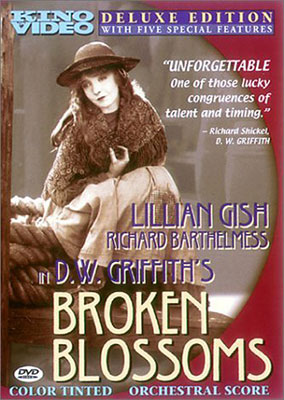 Kino International Kino International
2001 DVD edition
Broken Blossoms (1919), color-toned black & white, 90 minutes, not rated.
Kino International,
unknown catalog number, unknown UPC number.
One single-sided, dual-layered, Region 1 NTSC DVD disc, 1.33:1 aspect ratio image in full-frame 4:3 (720 x 480 pixels) interlaced scan MPEG-2 format, SDR (standard dynamic range), ? Mbps average video bit rate, ? Kbps audio bit rate, Dolby Digital 48 kHz 2.0 stereo sound, English language intertitles, no foreign language subtitles, chapter stops; standard DVD keepcase; $29.95.
Release date: 20 February 2001.
Country of origin: USA
Ratings (1-10): video: 9 / audio: 8 / additional content: 7 / overall: 8.
|
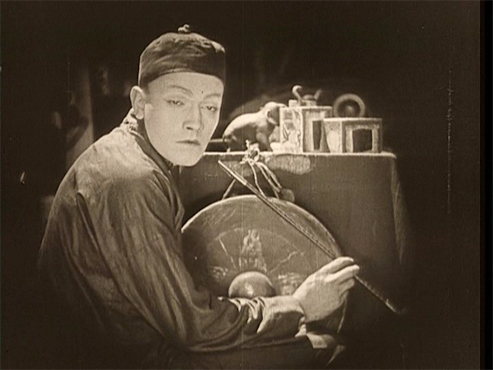
This original Kino DVD edition is virtually identical to the 2002 edition reviewed above.
|
|
USA: Click the logomark to purchase this Region 1 NTSC DVD edition from Amazon.com. Your purchase supports Silent Era.
|

|
|
|
Canada: Click the logomark at right to purchase this Region 1 NTSC DVD edition from Amazon.ca. Your purchase supports Silent Era.
|

|
|
 Film Preservation Associates Film Preservation Associates
1999 DVD edition
Broken Blossoms (1919), color-toned black & white, 95 minutes, not rated.
Film Preservation Associates, distributed by Image Entertainment, ID4720DSDVD, UPC 0-14381-47202-8.
One single-sided, single-layered, Region 0 NTSC DVD disc, 1.33:1 aspect ratio image in full-frame 4:3 (720 x 480 pixels) interlaced scan MPEG-2 format, SDR (standard dynamic range), ? Mbps average video bit rate, ? Kbps audio bit rate, Dolby Digital 48 kHz 2.0 mono sound, English language intertitles, no foreign language subtitles, chapter stops; snapper DVD case; $24.99.
Release date: 11 May 1999.
Country of origin: USA
Ratings (1-10): video: 6 / audio: 4 / additional content: 8 / overall: 6.
|
|
Of the print used for this Image Entertainment DVD edition’s video transfer, we can say that it looks as good as any other 35mm print we have seen of the film. As can be expected for a film of this age there is some wear on the print that was utilized (mostly emulsion scratches and chipping), however, it is rarely distracting. The detail of textures in clothing is rendered better on this DVD than on laserdisc versions of the film. Our primary complaint about this video transfer is that it is too dark. Background picture detail is lost throughout the film to shadowy depths behind the actors. At times the backgrounds are too dark to follow actors’ movements deep in the shots.
An A-B comparison of this DVD and Image Entertainment’s 1989 laserdisc version of David Gill and Kevin Brownlow’s presentation of Broken Blossoms reveals deficiencies in the video transfers of both the DVD and laserdisc editions. In addition to the darkness of David Shepard’s DVD version, that transfer overcrops the bottom of the picture by about 5 percent. The DVD does reveal more picture information, on the other hand, on the top and the sides of the frame. The result is that heads are nearly always in the frame, but many close-ups of Lillian Gish (who was, we think, deliberately shot low in the frame to give the effect of her being smaller than an adult) seem too low in the resultant framing. In the laserdisc edition Donald Crisp’s head is occasionally cut off at the hairline but the framing seems more natural. Toward the end of the film the DVD framing is vertically almost identical to that of the laserdisc, with the same additional amount of picture as seem earlier on both sides of the frame. The DVD could have considerably improved by slightly shrinking and windowboxing the picture to ensure a maximum viewable area on all televisions. From the final boxing sequence onward, the DVD projection rate increases and runs slightly faster than the laserdisc transfer.
The laserdisc version features a clearer, brighter video transfer. Background and shadow details are fully visible. The trade-off is that the laserdisc version has less detail in brighter areas such as faces and light clothing. At times, the laserdisc picture is overexposed compared to the DVD, with details lost in a — at times — too-bright transfer. The laserdisc has a softer picture quality, partially due to the laserdisc’s smaller number of picture resolution lines and also, we think, the result of downconverting an original PAL videotape transfer to NTSC. Ultimately, despite these minor shortcomings, we feel that the best home video presentation of Broken Blossoms remains Image Entertainment’s out-of-print laserdisc version (catalog number ID6861HB). The stereo music soundtrack adaptation by Carl Davis of Louis F. Gottschalk’s 1919 score adds immensely to the dramatic impact of the film. The DVD features a low-fidelity mono orchestral score that is serviceable.
Copies of the out-of-print laserdisc may possibly be found at auction on eBay, but for DVD collectors we recommend the Kino editions above.
|
|
USA: Click the logomark to purchase this Region 1 NTSC DVD edition from Amazon.com. Your purchase supports Silent Era.
|

|
|
|
Canada: Click the logomark to purchase this Region 1 NTSC DVD edition from Amazon.ca. Your purchase supports Silent Era.
|

|
|
 Eureka Entertainment Eureka Entertainment
2000 DVD edition
Broken Blossoms (1919), black & white, 88 minutes, BBFC Classification 15.
Eureka Entertainment,
unknown catalog number, unknown UPC number.
One single-sided, dual-layered, Region 2 PAL DVD disc, 1.33:1 aspect ratio image in full-frame 4:3 (720 x 576 pixels) interlaced scan MPEG-2 format, SDR (standard dynamic range), ? Mbps average video bit rate, ? Kbps audio bit rate, Dolby Digital 48 kHz 2.0 mono? sound, English language intertitles, no foreign language subtitles, chapter stops; standard DVD keepcase; £19.99.
Release date: 16 October 2000.
Country of origin: England
|
|
This high-quality PAL DVD edition presents the viewer with the unique optional choice of viewing of each of the four stories from Intolerance contiguously.
North American collectors will need a region-free PAL DVD player capable of outputting an NTSC-compatible signal to view this edition.
|
|
United Kingdom: Click the logomark to purchase this Region 2 PAL DVD edition from Amazon.co.uk. Your purchase supports Silent Era.
|

|
|
 Eureka Entertainment Eureka Entertainment
2002 DVD edition
D.W. Griffith Monumental Epics (1915-1930), color-toned black & white and black & white, 693 minutes total, BBFC Classification PG, 15 and U,
including Broken Blossoms (1919), black & white, 88 minutes, BBFC Classification 15.
Eureka Entertainment,
unknown catalog number, unknown UPC number.
Four single-sided, dual-layered, Region 2 PAL DVD discs, 1.33:1 aspect ratio image in full-frame 4:3 (720 x 576 pixels) interlaced scan MPEG-2 format, SDR (standard dynamic range), ? Mbps average video bit rate, ? Kbps audio bit rate, Dolby Digital 48 kHz 2.0 mono and stereo sound, English language intertitles, no foreign language subtitles, chapter stops; standard DVD keepcase in cardboard slipcase; £49.99.
Release date: 24 June 2002.
Country of origin: England
|
|
This PAL DVD boxset edition includes the above-noted Eureka edition of Broken Blossoms, plus four other Griffith films from Eureka.
North American collectors will need a region-free PAL DVD player capable of outputting an NTSC-compatible signal to view this edition.
|
|
United Kingdom: Click the logomark to purchase this Region 2 PAL DVD edition from Amazon.co.uk. Support Silent Era.
|

|
|
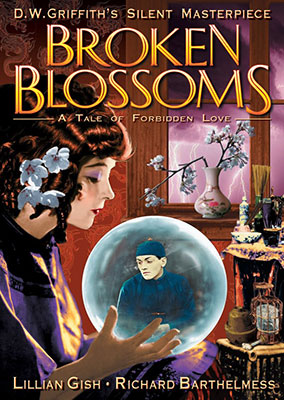 Alpha Video Alpha Video
2005 DVD edition
Broken Blossoms (1919), black & white, 75 minutes, not rated.
Alpha Home Entertainment, distributed by Oldies.com,
ALP 4741D, UPC 0-89218-47419-3.
One single-sided, single-layered, Region 0 NTSC DVD-R disc; 1.33:1 aspect ratio picture in full-frame 4:3 (720 x 480 pixels) interlaced scan image encoded in SDR MPEG-2 format at 7.0 Mbps average video bit rate (capable of progressive scan upscaling to 60 fps); Dolby Digital (AC3) 2.0 mono sound encoded at 192 Kbps audio bit rate; English language intertitles, no foreign language subtitles; 7 chapter stops; standard DVD keepcase; $6.98 (raised to $8.98).
Release date: 26 April 2005.
Country of origin: USA
Ratings (1-10): video: 6 / audio: 6 / additional content: 0 / overall: 6.
|

This budget DVD edition has been mastered from a very-good 16mm reduction print, and is accompanied by the orchestral soundtrack from a 1930s sound rerelease of the film. The source print has a reasonable range of greytones, but shadows remain dark, as in most prints of the film, and image details are soft. Because the video transfer has been made from a sound print that runs at 24 frames a second, the action moves unnaturally fast, accounting for the difference in running time compared to the silent-speed editions noted above.
A faint Alpha Video logo appears in the upper right-hand corner of the main title card. Thankfully, it doesn’t appear throughout the film.
This inexpensive edition is watchable, but we still recommend the 2001 Kino edition noted above.
|
|
USA: Click the logomark to purchase this Region 0 NTSC DVD-R edition from Amazon.com. Your purchase supports Silent Era.
|

|
|
|
Canada: Click the logomark to purchase this Region 0 NTSC DVD-R edition from Amazon.ca. Your purchase supports Silent Era.
|

|
|
 The Film Detective The Film Detective
2015 DVD edition
Broken Blossoms (1919), black & white, 90 minutes, not rated.
The Film Detective,
unknown catalog number, UPC 8-89290-22510-8.
One single-sided, single-layered, Region 0 NTSC DVD-R disc; 1.33:1 aspect ratio picture in full-frame 4:3 (720 x 480 pixels) interlaced scan image encoded in SDR MPEG-2 format at ? Mbps average video bit rate (capable of progressive scan upscaling to ? fps); Dolby Digital (AC3) 2.0 mono sound encoded at ? Kbps audio bit rate; English language intertitles, no foreign language subtitles; chapter stops; standard DVD keepcase; $9.99.
Release date: 7 July 2015.
Country of origin: USA
|
|
This DVD-R edition has likely been mastered from a 16mm reduction print.
The film is likely accompanied by a soundtrack compiled from preexisting recordings.
|
|
USA: Click the logomark to purchase this Region 0 NTSC DVD-R edition from Amazon.com. Your purchase supports Silent Era.
|

|
|
|
Other silent era D.W. GRIFFITH films available on home video.
Other silent era LILLIAN GISH films available on home video.
Other silent era RICHARD BARTHELMESS films available on home video.
Other ASIAN-THEMED FILMS of the silent era available on home video.
|
|
Lillian Gish filmography in The Progressive Silent Film List
|
|
|

SUPPORT SILENT ERA
USING THESE LINKS
WHEN SHOPPING AT
AMAZON



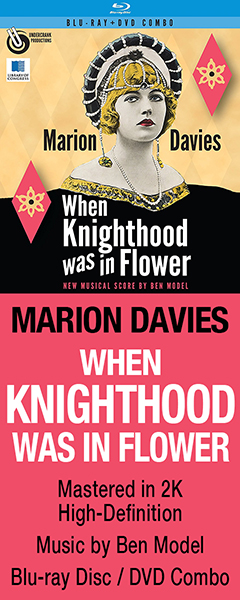






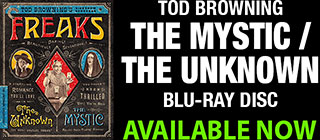


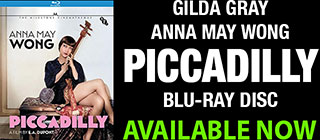




















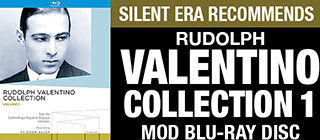








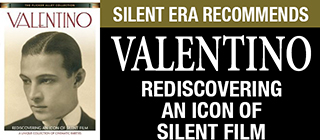

















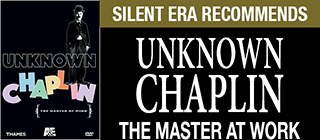

|





































